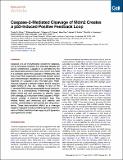| dc.contributor.author | Oliver, Trudy | |
| dc.contributor.author | Meylan, Etienne | |
| dc.contributor.author | Chang, Gregory P. | |
| dc.contributor.author | Xue, Wen | |
| dc.contributor.author | Burke, James R. | |
| dc.contributor.author | Humpton, Timothy J. | |
| dc.contributor.author | Hubbard, Diana D. | |
| dc.contributor.author | Bhutkar, Arjun (AJ) | |
| dc.contributor.author | Jacks, Tyler E. | |
| dc.date.accessioned | 2015-03-04T17:31:57Z | |
| dc.date.available | 2015-03-04T17:31:57Z | |
| dc.date.issued | 2011-07 | |
| dc.date.submitted | 2011-05 | |
| dc.identifier.issn | 10972765 | |
| dc.identifier.issn | 1097-4164 | |
| dc.identifier.uri | http://hdl.handle.net/1721.1/95804 | |
| dc.description.abstract | Caspase-2 is an evolutionarily conserved caspase, yet its biological function and cleavage targets are poorly understood. Caspase-2 is activated by the p53 target gene product PIDD (also known as LRDD) in a complex called the Caspase-2-PIDDosome. We show that PIDD expression promotes growth arrest and chemotherapy resistance by a mechanism that depends on Caspase-2 and wild-type p53. PIDD-induced Caspase-2 directly cleaves the E3 ubiquitin ligase Mdm2 at Asp 367, leading to loss of the C-terminal RING domain responsible for p53 ubiquitination. As a consequence, N-terminally truncated Mdm2 binds p53 and promotes its stability. Upon DNA damage, p53 induction of the Caspase-2-PIDDosome creates a positive feedback loop that inhibits Mdm2 and reinforces p53 stability and activity, contributing to cell survival and drug resistance. These data establish Mdm2 as a cleavage target of Caspase-2 and provide insight into a mechanism of Mdm2 inhibition that impacts p53 dynamics upon genotoxic stress. | en_US |
| dc.description.sponsorship | Virginia and D.K. Ludwig Fund for Cancer Research (Postdoctoral Fellowship) | en_US |
| dc.description.sponsorship | Human Frontier Science Program (Strasbourg, France) (Fellowship) | en_US |
| dc.description.sponsorship | National Cancer Institute (U.S.) (Cancer Center Support (Core) Grant P30-CA14051) | en_US |
| dc.language.iso | en_US | |
| dc.publisher | Elsevier | en_US |
| dc.relation.isversionof | http://dx.doi.org/10.1016/j.molcel.2011.06.012 | en_US |
| dc.rights | Article is made available in accordance with the publisher's policy and may be subject to US copyright law. Please refer to the publisher's site for terms of use. | en_US |
| dc.source | Elsevier | en_US |
| dc.title | Caspase-2-Mediated Cleavage of Mdm2 Creates a p53-Induced Positive Feedback Loop | en_US |
| dc.type | Article | en_US |
| dc.identifier.citation | Oliver, Trudy G., Etienne Meylan, Gregory P. Chang, Wen Xue, James R. Burke, Timothy J. Humpton, Diana Hubbard, Arjun Bhutkar, and Tyler Jacks. “Caspase-2-Mediated Cleavage of Mdm2 Creates a P53-Induced Positive Feedback Loop.” Molecular Cell 43, no. 1 (July 2011): 57–71. © 2011 Elsevier Inc. | en_US |
| dc.contributor.department | Koch Institute for Integrative Cancer Research at MIT | en_US |
| dc.contributor.mitauthor | Bhutkar, Arjun (AJ) | en_US |
| dc.contributor.mitauthor | Jacks, Tyler E. | en_US |
| dc.contributor.mitauthor | Oliver, Trudy | en_US |
| dc.contributor.mitauthor | Meylan, Etienne | en_US |
| dc.contributor.mitauthor | Chang, Gregory P. | en_US |
| dc.contributor.mitauthor | Xue, Wen | en_US |
| dc.contributor.mitauthor | Burke, James R. | en_US |
| dc.contributor.mitauthor | Humpton, Timothy J. | en_US |
| dc.relation.journal | Molecular Cell | en_US |
| dc.eprint.version | Final published version | en_US |
| dc.type.uri | http://purl.org/eprint/type/JournalArticle | en_US |
| eprint.status | http://purl.org/eprint/status/PeerReviewed | en_US |
| dspace.orderedauthors | Oliver, Trudy G.; Meylan, Etienne; Chang, Gregory P.; Xue, Wen; Burke, James R.; Humpton, Timothy J.; Hubbard, Diana; Bhutkar, Arjun; Jacks, Tyler | en_US |
| dc.identifier.orcid | https://orcid.org/0000-0001-5785-8911 | |
| dspace.mitauthor.error | true | |
| mit.license | PUBLISHER_POLICY | en_US |
| mit.metadata.status | Complete | |
